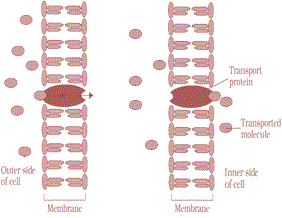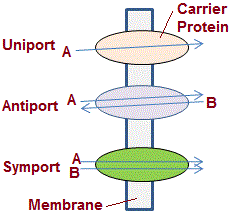Means of transport in plant
There is three means of tranport in plant without energy expenditure as follows:
1. Diffusion
Movement by diffusion is passive and may be :
from one part of the cell to the other or
from cell to cell or
over short distances,
from the intercellular spaces of the leaf to the outside.
In diffusion molecules move in a random fashion, the net result being substances moving from regions of higher concentration to regions of lower concentration.
In diffusion molecules move in a random fashion, the net result being substances moving from regions of higher concentration to regions of lower concentration.
Diffusion is a slow process and is not dependent on a ‘living system’. Diffusion is obvious in gases and liquids but diffusion in solids is more likely rather than of solids. Diffusion is very important to plants since it is the only means for gaseous movement within the plant body.
Diffusion rates are affected by the gradient of concentration, the permeability of the membrane separating them, temperature and pressure.
2. Facilitated Diffusion
A gradient must be present for diffusion to occur. The diffusion rate depends on the size of the substances means smaller substances diffuse faster. The diffusion of any substance across a membrane also depends on its solubility in lipids and the major constituent of the membrane. Substances soluble in lipids diffuse through the membrane faster.
Substances that have a hydrophilic moiety find it difficult to pass through the membrane, their movement has to be facilitated.
The membrane proteins provide sites at which such molecules cross the membrane. They do not set up a concentration gradient. This process is called facilitated diffusion.
In facilitated diffusion special proteins help to move substances across membranes without expenditure of ATP energy.
Facilitated diffusion cannot cause net transport of molecules from a low to a high concentration – this would require input of energy.
The transport rate reaches a maximum when all of the protein transporters are being used (saturation).
Facilitated diffusion is very specific (it allows cell to select substances for uptake). It is sensitive to inhibitors which react with protein side chains.

The proteins form channels in the membrane for molecules to pass through. Some channels are always open and others can be controlled.
Some are large allowing a variety of molecules to cross.
The porins are proteins that form large pores in the outer membranes of the plastids, mitochondria and some bacteria allowing molecules up to the size of small proteins to pass through.
An extracellular molecule bound to the transport protein, the transport protein then rotates and releases the molecule inside the cell (water channels – made up of eight different types of aquaporins).
Passive symports and antiports
Some carrier or transport proteins allow diffusion only if two types of molecules move together.
In a symport, both molecules cross the membrane in the same direction.
In an antiport, they move in opposite directions.
In uniport:an amolecule moves across a membrane independent of other molecules this process is called uniport.

3. Active Transport
Active transport uses energy to transport and pump molecules against a concentration gradient. Active transport is carried out by specific membrane-proteins.
The different proteins in the membrane play a major role in both active as well as passive transport.
Pumps are proteins that use energy to carry substances across the cell membrane. These pumps can transport substances from a low concentration to a high concentration (‘uphill’ transport).
Transport rate reaches a maximum when all the protein transporters are being used or are saturated.
Like enzymes the carrier protein is very specific in what it carries across the membrane.
These proteins are sensitive to inhibitors that react with protein side chains.
Comparison of different Transport Mechanisms
| Property | Simple Diffusion | Facilitated Transport | Active Transport |
|---|---|---|---|
| Requires special membrane proteins | No | Yes | Yes |
| Highly selective | No | Yes | Yes |
| Transport saturates | No | Yes | Yes |
| Uphill transport | No | No | Yes |
| Requires ATP energy | No | No | Yes |
The driving forces responsible ror Transportation
Followings are the driving forces responsible for the transportation of water and minerals in plants:
Transpiration
Force of surface tension
Water potential gradient
The force of hydrogen bonding between water molecules
